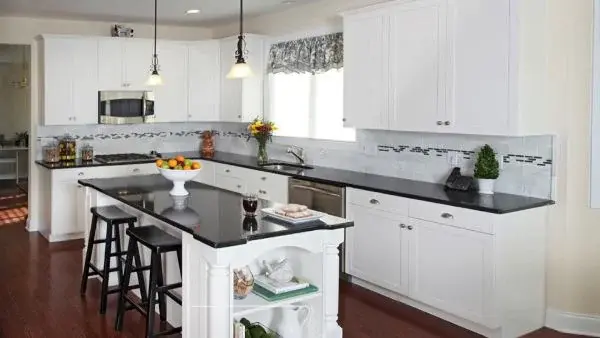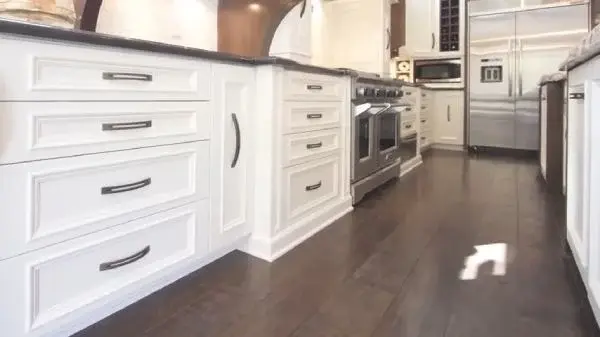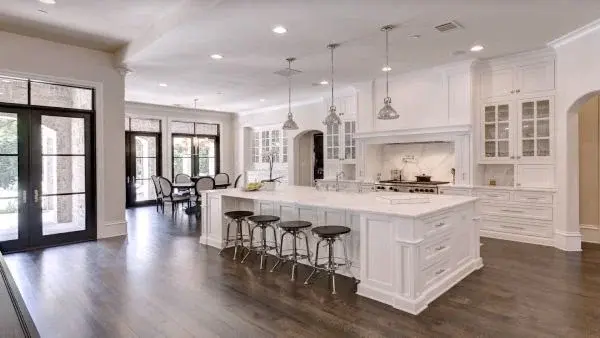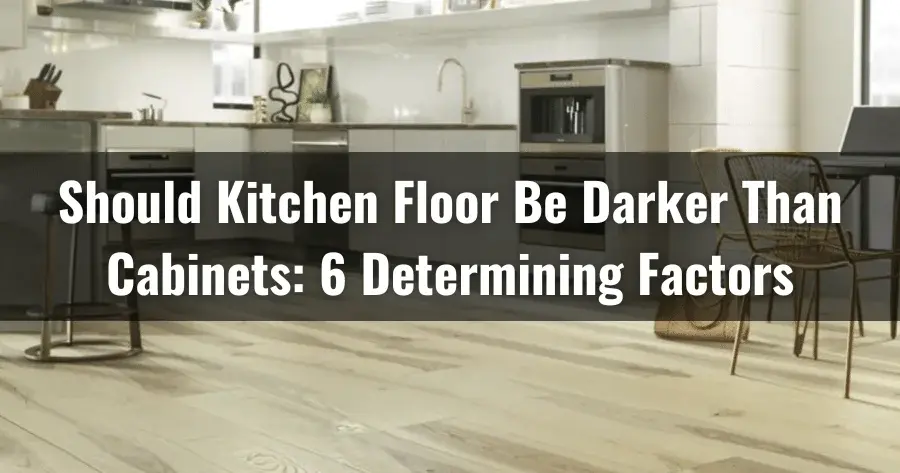Kitchen cabinets and floor color play a pivotal role in shaping a kitchen’s overall aesthetics and ambiance. The question often arises during a remodeling project: should the kitchen floor be darker than the cabinets?
No strict rule dictates the color of the kitchen floor in relation to the cabinets. But, we recommend creating contrast for a balanced and visually appealing space. This can be achieved by opting for lighter floors with darker cabinets or vice versa.
We will explore the principles that aid in determining whether the kitchen floor should be brighter or darker in contrast to the cabinets. Also, we will discuss why matching the colors of your kitchen cabinets and floor is not recommended
Let us embark on this exploration, where aesthetics and design converge, and discover the nuances contributing to creating a truly captivating kitchen space.
Principles to Determine Whether the Kitchen Floor Needs to Be Darker Than the Cabinets

There are several key principles to consider when deciding whether to make the floor darker than the cabinets. These are:
- Dominant Feature
- Room Size and Lighting
- Visual Focus
- Design Flexibility
- Contrast
- Mood and Ambiance
Let us take a closer look at the factors.
1. Dominant Feature
When considering whether to make the flooring darker than your kitchen cabinets, you need to pay attention to proportions.
Since your cabinetry is the main feature of the kitchen, a darker floor can help to balance the design and create a cohesive look.
This floor color may make the space cramped and crowded if you have a smaller kitchen. In this situation, a lighter floor can create the illusion of more space while maintaining a harmonious design.
2. Room Size and Lighting
Dark floors can make a small kitchen feel even smaller and claustrophobic, so we suggest you avoid them if you have a small kitchen without natural light.
In this case, a lighter floor will help reflect any available light, creating the illusion of more space and a brighter atmosphere.
But a darker floor can add warmth and coziness to your space if you have a large kitchen with plenty of natural light.
3. Visual Focus
When your cabinetry features ornate details or patterns, you need to choose a floor that complements rather than competes with your cabinets.
In this scenario, a lighter floor can help to draw attention to your beautiful cabinetry, making it the central focus of your kitchen.
Based on real life and most people’s observations, we found that if your floor is lighter than your cabinets, you can highlight the details and intricacies of your cabinetry.
4. Design Flexibility
Neutral wood or stone floors offer exceptional flexibility and can work well with any color and style of cabinets.
Choosing a natural-colored floor allows your cabinets to take center stage, creating a sense of depth and visual interest.
Adding different textures to your flooring creates an interesting, textured look that further enhances your cabinets’ beauty.
5. Contrast
Contrasting the color of your cabinets and floor can add depth and visual interest to your kitchen design. You create a striking contrast with lighter-colored cabinets by choosing a darker shade for the floor of your kitchen.
This contrast adds dimension to the space and helps highlight the beauty of both elements. Each component can stand out independently, creating a visually appealing and well-balanced kitchen aesthetic.
6. Mood and Ambiance
Darker floors can be a great option if you want to create a moody and dramatic ambiance in your kitchen.
Pairing dark cabinets with a similarly toned dark floor can create a bold & striking modern and inviting look. This will create a warm and cozy space perfect for entertaining guests or relaxing with family.
Why Is It Recommended to Avoid Having Both the Cabinets and the Floor in Exactly the Same Color?

When considering the color scheme for your kitchen, avoiding having the cabinets and floor exactly the same color is recommended. The reasons are as follows:
1. Visual Monotony
Avoiding the cabinets and the floor in the same color can help you prevent visual monotony. A single-color scheme can result in the entire kitchen blending together, making it difficult for individual elements to stand out and catch your eye.
The lack of contrast can lead to a flat and uninteresting appearance, making the kitchen less inviting and aesthetically appealing.
You can create separation between the two major kitchen components by utilizing contrasting colors between the cabinets and the floor, enhancing its overall visual appeal.
2. Lack of Depth
We recommend you avoid using the same color for your kitchen cabinets and floor because different colors add depth and dimension.
Incorporating colors that contrast with the cabinets and flooring allows each element to create its impact, defining and separating the two major kitchen components.
This contrast enhances the overall visual appeal and creates a more inviting atmosphere.
3. Highlighting Focal Points
By incorporating a contrasting color on the floor, you can highlight the focal points in your kitchen design and truly make them pop.
In kitchen design, cabinets are often considered one of the main focal points. If you choose a darker floor, you create a visual contrast that allows the cabinets to take center stage. This draws attention to their unique design and details, enhancing the overall beauty of your kitchen.
4. Aesthetic Balance
Having both cabinets and floors the same color can create an unbalanced look, especially if the color is too dominant or overwhelming.
This can also lead to the kitchen feeling too monochromatic and less appealing. We suggest you use contrasting colors so that elements complement each other while still standing out.
5. Avoiding the “Boxed-In” Feeling
When the cabinets and the kitchen floor share the same color, the kitchen might feel enclosed or boxed in, lacking openness and visual flow. This can also limit visual stimulation, making the kitchen less interesting and inviting.
Utilizing different colors can help break up the visual space, creating a more dynamic and inviting environment that encourages culinary creativity.
6. Personalization and Character
Implementing different colors for the cabinets and floor allows for the personal infusion of your style and preferences. It provides a unique opportunity to add character to your kitchen space, making it stand out and look more distinct.
Including contrasting colors that display your personality and aesthetic taste can make the kitchen space feel more intimate and warm whilst giving off a modern and visually intriguing atmosphere.
This translates to a more homely and personal space, which individuals can relate to on a more sentimental level. It is our view, and we agree with many people that having a lighter color floor than cabinets will really make the kitchen look amazing.
FAQ’s: Should Kitchen Floor Be Darker Than Cabinets
Many homeowners ask many questions regarding the color of kitchen floors and cabinets. Below are some of them; we think you might have some too.
What color flooring goes best with dark kitchen cabinets?
Consider choosing gray or white hardwood flooring for your kitchen with dark cabinets, as these colors will complement the deep tones and bring a touch of light to the space. Gray and white hardwood flooring is known to go best with dark blue, green, and black cabinets.

If you go lighter on your flooring, you can create a balanced and visually appealing kitchen design that showcases your dark cabinets while adding brightness to the room.
What color flooring makes a kitchen look bigger?
To create the illusion of a larger kitchen, opt for light-colored flooring that enhances the spaciousness and adds a touch of brightness to your space. Light colors such as blues, greens, or pale yellows are ideal choices as they reflect more light and make the kitchen appear open and airy.
The contrast between light flooring and dark cabinets creates visual depth, making the room feel more expansive. Our suggestion is to use light-colored flooring to make your kitchen look bigger than it is.
How do you lighten a room with dark cabinets?
One way to brighten up a dark room is to add recessed lighting in strategic spots to help distribute light and eliminate shadows. Another helpful method is to incorporate reflective surfaces such as stainless steel or gloss tile, which can help to reflect light and bounce it around the room.
Installing under-cabinet lighting can also contribute to welcoming illumination by offering a direct light source in the areas where it’s needed most.
Conclusion
So, now you know choosing a darker floor than cabinets isn’t about strict rules, but choosing a lighter color than cabinets is best.
You can strike the right balance by considering factors like the dominant features, room size, and lighting. A contrast between the color of the floor and the cabinetry adds depth and makes your kitchen stand out.
Remember, it’s best to avoid having the cabinets and floor the same color to prevent monotony and lack of visual interest.
So, get creative, play with colors, and design a kitchen that reflects your style and makes you feel at home while cooking your favorite dishes.



